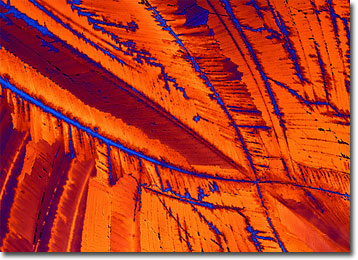Polarized Light Microscopy Digital Image Gallery
Sodium Oleate
As a fatty acid, sodium oleate is not generally found free in nature, but rather occurs as a component of more complex naturally occurring lipids. In its isolated form, however, the substance exudes a tallow-like scent and is a white crystalline solid at room temperature.

Sodium oleate is utilized for a variety of commercial purposes, especially the production of soap. The soaps made from the fatty acid are considered synthetic although their manufacture only requires a few steps to complete. Sodium oleate is also often used in the production of insoluble metallic stearates via what is known as the double decomposition method. Other uses of the fatty acid include its inclusion in industrial lubricants and various oil-based cosmetics as a thickening or gelling agent.
Sodium oleate is an unsaturated fatty acid that features a kink in the long-chain hydrocarbon tail of its molecules due to a cis double bond. Though the biochemical is already being utilized for a variety of applications, scientists are currently investigating the fatty acid in hopes of coming to a better understanding of the substance and finding additional uses for it. In one recent study, for instance, researchers attempted to determine whether damage to the intestinal mucosa by oleic acid in its neutralized form of sodium oleate causes the suppression of food intake, while another explored whether or not sodium oleate affects bile or pancreatic secretions when infused into various parts of the body.
